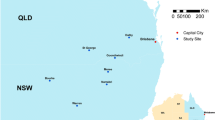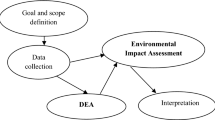Abstract
General circulation models (GCMs) project increases in the earth’s surface air temperatures and other climate changes by the mid or late 21st century, and therefore crops such as cotton (Gossypium spp L.) will be grown in a much different environment than today. To understand the implications of climate change on cotton production in India, cotton production to the different scenarios (A2, B2 and A1B) of future climate was simulated using the simulation model Infocrop-cotton. The GCM projections showed a nearly 3.95, 3.20 and 1.85 °C rise in mean temperature of cotton growing regions of India for the A2, B2 and A1B scenarios, respectively. Simulation results using the Infocrop-cotton model indicated that seed cotton yield declined by 477 kg ha−1 for the A2 scenario and by 268 kg ha−1 for the B2 scenario; while it was non-significant for the A1B scenario. However, it became non-significant under elevated [CO2] levels across all the scenarios. The yield decline was higher in the northern zone over the southern zone. The impact of climate change on rainfed cotton which covers more than 60 % of the country’s total cotton production area (mostly in the central zone) and is dependent on the monsoons is likely to be minimum, possibly on account of marginal increase in rainfall levels. Results of this assessment suggest that productivity in northern India may marginally decline; while in central and southern India, productivity may either remain the same or increase. At the national level, therefore, cotton production is unlikely to change with climate change. Adaptive measures such as changes in planting time and more responsive cultivars may further boost cotton production in India.




Similar content being viewed by others
Explore related subjects
Discover the latest articles and news from researchers in related subjects, suggested using machine learning.References
Aggarwal PK, Joshi PK, Ingram JSI, Gupta RK (2004) Adopting food systems of the Indo-Gangetic plains to global environmental change: key information needs to improve policy formulation. Environ Sci Policy 7:487–498
Aggarwal PK, Kalra N, Chander S, Pathak H (2006) InfoCrop: a dynamic simulation model for the assessment of crop yields, losses due to pests, and environmental impact of agro-ecosystems in tropical environments. I. Model description. Agric Syst 89:1–25
Boomiraj K, Chakrabarti B, Aggarwal PK, Choudhary R, Chander S (2010) Assessing the vulnerability of Indian mustard to climate change. Agric Ecosyst Environ 138:265–273
Byjesh K, Kumar Naresh S, Aggarwal PK (2010) Simulating impacts, potential adaptation and vulnerability of maize to climate change in India. Mitig Adapt Strateg Glob Chang. doi:10.1007/s11027-010-9224-3;15:413-431
Fitter AH, Hay RKM (1987) Environmental physiology of plants, 2nd edn. Academic, London
Gerik TT, Oosterhuis DM, Tolbert HA (1998) Managing cotton nitrogen supply. Adv Agron 64:115–147
Hebbar KB, Venugopalan MV, Rao MRK, Gadade GD, Chatterjee S, Mayee CD (2003) Effect of sowing dates and fertilizer levels on phenology, growth and yield of cotton. Indian J Plant Physiol 7:380–383
Hebbar KB, Perumal NK, Khadi BM (2007a) Photosynthesis and plant growth response of transgenic Bt cotton (Gossypium hirsutum L.) hybrids under field condition. Photosynthetica 45:254–258
Hebbar KB, Rao MRK, Khadi BM (2007b) Synchronised boll development of Bt cotton hybrids and their physiological consequences. Current Sci 93:693–695
Hebbar KB, Venugopalan MV, Seshasai MVR, Rao KV, Patil BC, Prakash AH, Kumar V, Hebbar KR, Jeyakumar P, Bandhopadhyay KK, Rao MRK, Khadi BM, Aggarwal PK (2008) Predicting cotton production using Infocrop-cotton simulation model, remote sensing and spatial agro-climatic data. Curr Sci 95:1570–1580
IPCC (2007) Climate change, 2007: the physical science basis. Inter-governmental Panel for Climate Change, Cambridge University Press, Cambridge, UK
Kimball BA (1983) Carbon dioxide and agricultural yield: an assemblage and analysis of 430 prior observations. Agron J 75:775–778
Kumar KR, Sahai KA, Kumar K, Patwardhan KS, Mishra KP, Revadekar VJK, Pant GB (2006) High resolution climate change scenarios for India for the 21st Century. Curr Sci 90:3
Naresh Kumar S, Kasturi Bai KV, Rajagopal V, Aggarwal PK (2008) Simulating coconut growth, development and yield with the InfoCrop-coconut model. Tree Physiol 28:1049–1058
O’Brien K, Leichenkob K, Kelkar U, Venemad H, Aandahla G, Tompkinsa H, Javed A, i Bhadwal S, Bargd S, Nygaarda L, Westa J (2004) Mapping and globalization in India. Glob Environ Chang 14: 303–313
Reddy KR, Hodges HF, McKinion JM (1997) A comparison of scenarios for the effect of global climate change on cotton growth and yield. Aust J Plant Physiol 24:707–713
Reddy KR, Hodges HF, Kimball BA (2000) Crop ecosystem responses to climate change: cotton. In: Reddy KR, Hodges HF (eds) Climate change and global crop productivity. CABI, Wallingford, UK, pp 161–187
Reilly JM, Schimmelpfennig D (1999) Agricultural impact assessment, vulnerability, and the scope for adaptation. Clim Chang 43:745–788
Rosenzweig C, Iglesias A (1998) The use of crop models for international climate change impact assessment. In: Tsuji GY, Googenboom G, Thornton PK (eds) Understanding options for agricultural production. Kluwer, London, pp 267–292
Rosenzweig C, Hillel D (1998) Climate change and the global harvest. Oxford University Press, Oxford, UK
Singh JP, Govindakrishnan PM, Lal SS, Aggarwal PK (2005) Increasing the efficiency of agronomy experiments in potato using InfoCrop-POTATO model. J Potato Res 48:131–152
Singh J, Rao MRK, Mohan P, Mayee CD (2006) Impact of soil depths on yield of Bt cotton hybrids under rainfed conditions. J Cotton Res Dev 20:80–82
Srivastava A, Naresh Kumar S, Aggarwal PK (2010) Assessment on vulnerability of sorghum to climate change in India. Agric Ecosyst Environ 138:160–169
van Kraalingen DWG (1995) The FSE system for crop simulation , version 2.1. Quantitative approaches in systems analysis. Report no. 1, AB/DLO, PE, Wageningen, The Netherlands
Venugopalan MV, Tiwary P, Hebbar KB, Ramamurthy V, Chatterji S, Rao KV, Sen TK, Deshmukh HV, Wahane MR (2007) Evaluation of Infocrop-cotton model in some shrink–swell soils under rainfed conditions. Agropedology 17:34–40
Acknowledgements
We greatly acknowledge the help offered by the Indian Institute of Tropical Meteorology (IITM), Pune, and by Dr. Sandhya Rao of INRM Consultants, for supplying future climate scenarios for our study.
Author information
Authors and Affiliations
Corresponding author
Electronic supplementary material
Below is the link to the electronic supplementary material.
ESM
The description, parameters and relationships needed to build the functions in the Infocrop-cotton model. (DOCX 41 kb)
Rights and permissions
About this article
Cite this article
Hebbar, K.B., Venugopalan, M.V., Prakash, A.H. et al. Simulating the impacts of climate change on cotton production in India. Climatic Change 118, 701–713 (2013). https://doi.org/10.1007/s10584-012-0673-4
Received:
Accepted:
Published:
Issue Date:
DOI: https://doi.org/10.1007/s10584-012-0673-4




